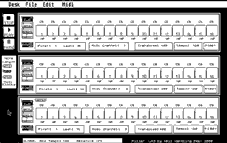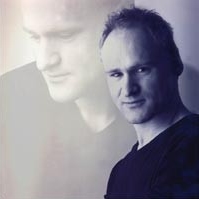Neil Wakeling talks about his deepest
love
I was first introduced to the Atari
as a Music Technology student at York University, England
in 1990. York had a pioneering Music Technology course,
one of the first in the country. I had recently graduated
with a degree in Electronic Engineering, and was delighted
to be in a roomful of computers and various keyboards
û studying my deepest love. The course was truly groundbreaking
and mixed students from any discipline û we had musicians,
engineers, chemists, philosophersà this resulted in
some great discussions! Subjects included: the mechanics
of sound and the inner ear; acoustics and room design;
electronic circuit theory; harmonics; MIDI; music composition;
CSOUND system; computer programming in C; and MIDI programming.
There were 10 or so workstations,
each with an Atari , MIDI keyboard (assorted Kawais,
Yamaha Dx7, Korg M1à) and various effects units. Each
Atari was equipped with a massive and fragile 300MB
hard disk (this was 1990), and the departmentÆs own
invention û a 16-bit digital sound system using a Betamax
video recorder going through a custom electronic board
into the cartridge port. The department had their own
software suite, with graphical sound recording and editing
software on each Atari û many of those tools that we
now take for granted were developed here.
York also had the CSOUND music system
û an immensely powerful music language, in which you
define all the parameters making up virtual instruments
along with frequencies and duration, and then set the
computer to make up the sound. Any synthesis method
can be implemented so long as you can work out how to
program it! Unfortunately, extreme dedication was required,
as the system would take many hours on the AtariÆs 8MHz
engine. Frequently we would leave the system running
overnight with the monitor turned off, to achieve just
a few minutes of sound. CSOUND is a platform-independent
system and can be run on Mac, PC and Unix. These days
it runs in real-time on a modern PC. I would not recommend
anybody to use CSOUND on an Atari û keep it for what
it's good at, namely MIDI!
In 1992 I bought an Atari STe system
with 4 MB RAM, Canon Bubblejet printer, and later adding
in a SCSI 100MB drive, with Cubase. The Falcon had been
rumoured for so long but they were just impossible to
get hold of, and computer shops were dropping the Atari,
making it difficult to keep in touch with the Atari
scene. My partner started a PhD in Highland History
at this time, so the Atari disappeared from the music
studio! I bought ThatÆs Write 2, in my opinion a first
class word processor which easily handled the task of
writing an academic thesis, with many features that
I find lacking in Word.
Using my knowledge of MIDI and C programming,
I wrote several programs (using the excellent freeware
Sozobon C compiler, and a registered copy of "Everest"
text editor. This editor has many features that make
it an invaluable programrÆs tool. The major project
was a projector controller. Using two slide projectors,
I designed the electronics and control software for
the Atari to run an audio-visual show, with crossfades,
transport control, and independent brightness control
for each. I have successfully given many public performances
with the system, synchronised to my music. The system
uses the modem port, with the serial signal being decoded
to give the voltages for each projector. A future version
(if it gets that far) will use the cartridge port, to
allow greater bit-resolution and also the ability to
control more than two lights at once.

The next project was "Pulsar".
This started as an experiment to write something different,
and is a recreation of an old analogue-style sequencer.
There are three rows each with up to 16 notes, with
various playback controls. The feature making it stand
out is that each row has an independent tempo control - prompted by my experiences
at York where we were encouraged to think beyond the
obvious. I have continued to develop Pulsar in my spare
time with much help and feedback coming from Tim Conrardy
and the Atari-MIDI mailing list. The computer keypad
can now be used for example to transpose sequences in
real time. Pulsar is available from my web site, and is
now up to version 1.5. The latest improvement has added
a control row, to send strings of control messages as
part of each sequence. Unfortunately this has had an
impact on the timing tightness so it is only available
as a Beta. Pulsar is free to anyone who wants to use
it - although it has turned into "CD-ware"
- several users have sent me CDs of their music featuring
Pulsar, or have bought my CD in exchange.
Although the Atari was my only computer
(running e-mail, Internet and desktop publishing with
Timeworks and Calamus), eventually I moved with the
times and built a PC for my work as a self-employed
computer consultant and technology trouble-shooter.
There are still a few web sites around that I created
using Everest, hand-coding the hard way! This training
has been invaluable for fixing the code generated by
some bloated Windows WYSIWYG web creation programs.
I teach Mac and Windows, Microsoft Office, graphics
with Photoshop, design databases and still find time
to do some music. Atari runs under TOSBOX, which I find
an excellent emulator for non-MIDI work. Incidentally,
I have found some of the Atari disk tools to be invaluable
for reading Mac and PC disks for data recovery, which
have become unreadable on their native systems.
My music making these days uses the
strengths of each system - Cool Edit Pro on the PC for
multi-track recording, wave file editing, and CD recording,
while the Atari runs MIDI composition software and various
editors. Only on the Atari platform is there such an
array of intriguing and sometimes off-the-wall software.
For full details of these programs I suggest you check
out Tim ConrardyÆs extensive site at http://sites.netscape.net/timconrardy/index.htm.
The internet has become the saviour
of the Atari platform, bringing enthusiasts and newcomers
together. I meet many people who fondly remember their
Atari systems from 10 years ago whilst swearing at Windows,
and are amazed when I tell them that my Atari is up
there, still e-mailing (no danger of viruses) and going
strong.
Finally, remember to switch off the
computer sometimes and go play with real people! My
music making also involves playing Scottish Highland
fiddle and didgeridoo. I recently helped with organising
a weekend festival of traditional music workshops, sessions
and concerts. See http://www.strathspeyinmay.com for more details of this to-be annual event.
Equipment
- Ensoniq VFX-SD û my main keyboard,
with a great interface, deep sounds and well thought
out internal sequencer.
- Korg Poly-800
- Home-made voltage controlled
monosynth circa 1985, fabulous sounds but unplayable
as the keyboard contacts are so incredible to maintain!
- Yamaha TX81Z expander û IÆve
gad it from new and love the possibilities of FM
synthesis.
- Alesis Quadraverb.
- Tascam 4-track
- Atari STE running Cubase, TX81Z
editor and librarian, fantastic VFX editor by Marcus
Grimm and various composition programs.
- PC running Cool Edit Pro, Guillemot
ISIS 8-track audio card.
- Fiddle
- Didgeridoo by Bruce Rogers
A
portrait of Neil Wakeling
Born in the Highlands
of Scotland Neil Wakeling has been interested
in, and playing music since his earliest
memories. As well as being a talented musician
he is an electronics engineer with an MSC
in Music Technology. He is gifted with a
wonderful power of creativity and a deep
understanding of the technology and science
of sound. This unique combination can be
heard distinctly in his music.
Neil has composed a number
of albums including soundtracks for television.
He organises traditional music workshops
as well as healing sound workshops and is
training as a vibrational sound healer.
He has recently completed a set of 7 meditation
and relaxation CDs with Gaia Visions, and
a new CD of "Imagination Music".
See http://www.dancing-dog.co.uk for more details, or e-mail neil@dancing-dog.co.uk

|
|